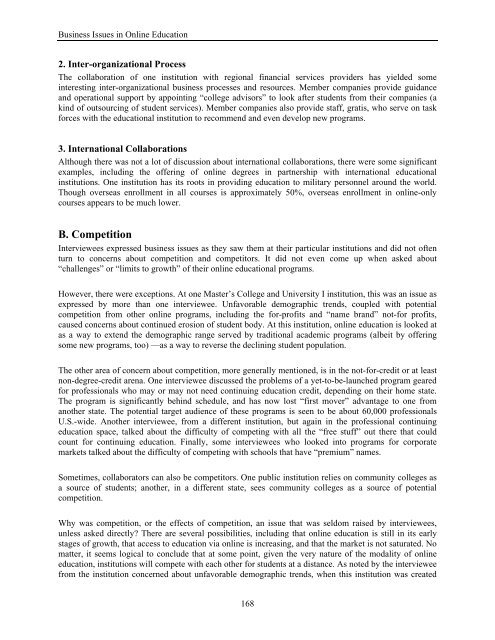Elements of Quality Online Education cation
Elements of Quality Online Education cation
Elements of Quality Online Education cation
Create successful ePaper yourself
Turn your PDF publications into a flip-book with our unique Google optimized e-Paper software.
Business Issues in <strong>Online</strong> <strong>Edu<strong>cation</strong></strong>2. Inter-organizational ProcessThe collaboration <strong>of</strong> one institution with regional financial services providers has yielded someinteresting inter-organizational business processes and resources. Member companies provide guidanceand operational support by appointing “college advisors” to look after students from their companies (akind <strong>of</strong> outsourcing <strong>of</strong> student services). Member companies also provide staff, gratis, who serve on taskforces with the edu<strong>cation</strong>al institution to recommend and even develop new programs.3. International CollaborationsAlthough there was not a lot <strong>of</strong> discussion about international collaborations, there were some significantexamples, including the <strong>of</strong>fering <strong>of</strong> online degrees in partnership with international edu<strong>cation</strong>alinstitutions. One institution has its roots in providing edu<strong>cation</strong> to military personnel around the world.Though overseas enrollment in all courses is approximately 50%, overseas enrollment in online-onlycourses appears to be much lower.B. CompetitionInterviewees expressed business issues as they saw them at their particular institutions and did not <strong>of</strong>tenturn to concerns about competition and competitors. It did not even come up when asked about“challenges” or “limits to growth” <strong>of</strong> their online edu<strong>cation</strong>al programs.However, there were exceptions. At one Master’s College and University I institution, this was an issue asexpressed by more than one interviewee. Unfavorable demographic trends, coupled with potentialcompetition from other online programs, including the for-pr<strong>of</strong>its and “name brand” not-for pr<strong>of</strong>its,caused concerns about continued erosion <strong>of</strong> student body. At this institution, online edu<strong>cation</strong> is looked atas a way to extend the demographic range served by traditional academic programs (albeit by <strong>of</strong>feringsome new programs, too) —as a way to reverse the declining student population.The other area <strong>of</strong> concern about competition, more generally mentioned, is in the not-for-credit or at leastnon-degree-credit arena. One interviewee discussed the problems <strong>of</strong> a yet-to-be-launched program gearedfor pr<strong>of</strong>essionals who may or may not need continuing edu<strong>cation</strong> credit, depending on their home state.The program is significantly behind schedule, and has now lost “first mover” advantage to one fromanother state. The potential target audience <strong>of</strong> these programs is seen to be about 60,000 pr<strong>of</strong>essionalsU.S.-wide. Another interviewee, from a different institution, but again in the pr<strong>of</strong>essional continuingedu<strong>cation</strong> space, talked about the difficulty <strong>of</strong> competing with all the “free stuff” out there that couldcount for continuing edu<strong>cation</strong>. Finally, some interviewees who looked into programs for corporatemarkets talked about the difficulty <strong>of</strong> competing with schools that have “premium” names.Sometimes, collaborators can also be competitors. One public institution relies on community colleges asa source <strong>of</strong> students; another, in a different state, sees community colleges as a source <strong>of</strong> potentialcompetition.Why was competition, or the effects <strong>of</strong> competition, an issue that was seldom raised by interviewees,unless asked directly? There are several possibilities, including that online edu<strong>cation</strong> is still in its earlystages <strong>of</strong> growth, that access to edu<strong>cation</strong> via online is increasing, and that the market is not saturated. Nomatter, it seems logical to conclude that at some point, given the very nature <strong>of</strong> the modality <strong>of</strong> onlineedu<strong>cation</strong>, institutions will compete with each other for students at a distance. As noted by the intervieweefrom the institution concerned about unfavorable demographic trends, when this institution was created168
















